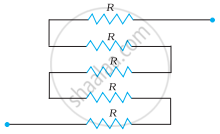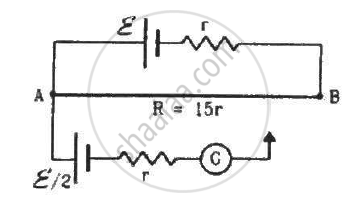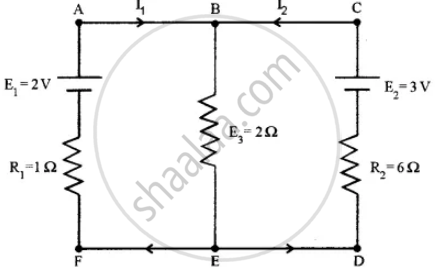Advertisements
Advertisements
प्रश्न
Given n resistors each of resistance R, how will you combine them to get the (i) maximum (ii) minimum effective resistance? What is the ratio of the maximum to minimum resistance?
उत्तर
Total number of resistors = n
Resistance of each resistor = R
(i) When n resistors are connected in series, effective resistance R1 is the maximum, given by the product nR.
Hence, the maximum resistance of the combination, R1 = nR
(ii) When n resistors are connected in parallel, the effective resistance (R2) is the minimum, given by the ratio `"R"/"n"`.
Hence, minimum resistance of the combination, R2 = `"R"/"n"`
The ratio of the maximum to the minimum resistance is,
`"R"_1/"R"_2 = ("nR")/("R"/"n") = "n"^2`
APPEARS IN
संबंधित प्रश्न
State the two Kirchhoff’s rules used in electric networks. How are there rules justified?
Determine the equivalent resistance of networks shown in Fig.

In the given circuit, assuming point A to be at zero potential, use Kirchhoff’s rules to determine the potential at point B.

Consider the potentiometer circuit as arranged in the figure. The potentiometer wire is 600 cm long. (a) At what distance from the point A should the jockey touch the wire to get zero deflection in the galvanometer? (b) If the jockey touches the wire at a distance of 560 cm from A, what will be the current in the galvanometer?

On which conservation principle is Kirchoff's Second Law of electrical networks based?
In the circuit shown in the figure below, E1 and E2 are two cells having emfs 2 V and 3 V respectively, and negligible internal resistance. Applying Kirchhoff’s laws of electrical networks, find the values of currents l1 and I2.

Two cell of 1.25 V and 0.75 V are connected parallel. The effective voltage will be:-
What is the advantage of using thick metallic strips to join wires in a potentiometer?
State the two Kirchhoff’s rules used in the analysis of electric circuits and explain them.
The figure below shows two batteries, E1 and E2, having emfs of 18V and 10V and internal resistances of 1 Ω and 2 Ω, respectively. W1, W2 and W3 are uniform metallic wires AC, FD and BE having resistances of 8 Ω, 6 Ω and 10 Ω respectively. B and E are midpoints of the wires W1 and W2. Using Kirchhoff's laws of electrical circuits, calculate the current flowing in the wire W3:

